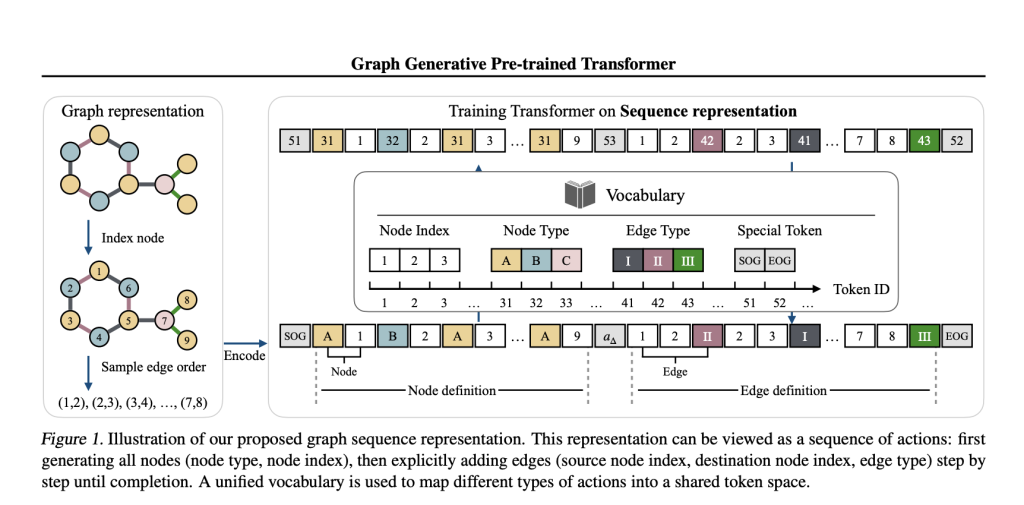

Graph generation is an important task across various fields, including molecular design and social network analysis, due to its ability to model complex relationships and structured data. Despite recent advancements, many graph generative models still rely heavily on adjacency matrix representations. While effective, these methods can be computationally demanding and often lack flexibility. This can make it difficult to efficiently capture the intricate dependencies between nodes and edges, especially for large and sparse graphs. Current approaches, including diffusion-based and auto-regressive models, face challenges in scalability and accuracy, highlighting the need for more refined solutions.
Researchers from Tufts University, Northeastern University, and Cornell University have developed the Graph Generative Pre-trained Transformer (G2PT), an auto-regressive model designed to learn graph structures through next-token prediction. Unlike traditional methods, G2PT uses a sequence-based representation of graphs, encoding nodes and edges as sequences of tokens. This approach streamlines the modeling process, making it more efficient and scalable. By leveraging a transformer decoder for token prediction, G2PT generates graphs that maintain structural integrity and flexibility. Additionally, G2PT is adaptable to downstream tasks such as goal-oriented graph generation and graph property prediction, making it a versatile tool for various applications.

Technical Insights and Benefits
G2PT introduces a sequence-based representation that divides graphs into node and edge definitions. Node definitions detail indices and types, while edge definitions outline connections and labels. This approach departs from adjacency matrix representations by focusing solely on existing edges, reducing sparsity and computational complexity. The transformer decoder effectively models these sequences through next-token prediction, offering several advantages:
- Efficiency: By addressing only existing edges, G2PT minimizes computational overhead.
- Scalability: The architecture is well-suited for handling large, complex graphs.
- Adaptability: G2PT can be fine-tuned for a variety of tasks, enhancing its utility across domains such as molecular design and social network analysis.
The researchers also explored fine-tuning methods for tasks like goal-oriented generation and graph property prediction, broadening the model’s applicability.
Experimental Results and Insights
G2PT has demonstrated strong performance across various datasets and tasks. In general graph generation, it matched or exceeded the performance of existing models across seven datasets. In molecular graph generation, G2PT showed high validity and uniqueness scores, reflecting its ability to accurately capture structural details. For example, on the MOSES dataset, G2PTbase achieved a validity score of 96.4% and a uniqueness score of 100%.
In a goal-oriented generation, G2PT aligned generated graphs with desired properties using fine-tuning techniques like rejection sampling and reinforcement learning. These methods enabled the model to adapt its outputs effectively. Similarly, in predictive tasks, G2PT’s embeddings delivered competitive results across molecular property benchmarks, reinforcing its suitability for both generative and predictive tasks.


Conclusion
The Graph Generative Pre-trained Transformer (G2PT) represents a thoughtful step forward in graph generation. By employing a sequence-based representation and transformer-based modeling, G2PT addresses many limitations of traditional approaches. Its combination of efficiency, scalability, and adaptability makes it a valuable resource for researchers and practitioners. While G2PT shows sensitivity to graph orderings, further exploration of universal and expressive edge-ordering mechanisms could enhance its robustness. G2PT exemplifies how innovative representations and modeling approaches can advance the field of graph generation.
Check out the Paper. All credit for this research goes to the researchers of this project. Also, don’t forget to follow us on Twitter and join our Telegram Channel and LinkedIn Group. Don’t Forget to join our 60k+ ML SubReddit.
 FREE UPCOMING AI WEBINAR (JAN 15, 2025): Boost LLM Accuracy with Synthetic Data and Evaluation Intelligence–Join this webinar to gain actionable insights into boosting LLM model performance and accuracy while safeguarding data privacy.
FREE UPCOMING AI WEBINAR (JAN 15, 2025): Boost LLM Accuracy with Synthetic Data and Evaluation Intelligence–Join this webinar to gain actionable insights into boosting LLM model performance and accuracy while safeguarding data privacy.
The post Graph Generative Pre-trained Transformer (G2PT): An Auto-Regressive Model Designed to Learn Graph Structures through Next-Token Prediction appeared first on MarkTechPost.
Source: Read MoreÂ



